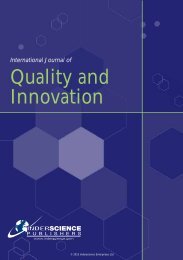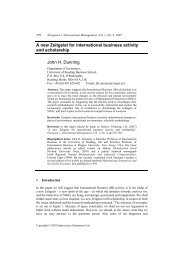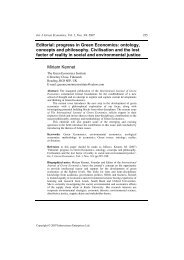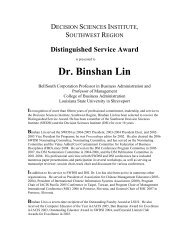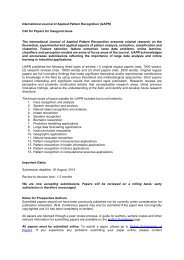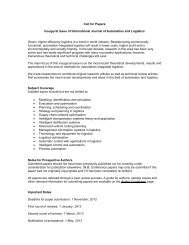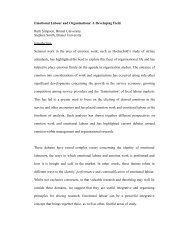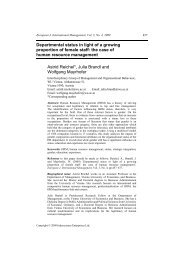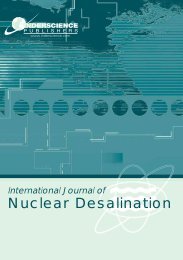in pdf - Inderscience Publishers
in pdf - Inderscience Publishers
in pdf - Inderscience Publishers
- No tags were found...
You also want an ePaper? Increase the reach of your titles
YUMPU automatically turns print PDFs into web optimized ePapers that Google loves.
Solv<strong>in</strong>g the Right Problem – A Cross Atlantic Experience between CMU and TU Delft. 1<br />
Paulien Herder and Eswaran Subrahmanian<br />
TU Delft, The Netherlands and Carnegie Mellon University, USA<br />
The course<br />
The course that we experimented with for our global eng<strong>in</strong>eer<strong>in</strong>g educational activity is the<br />
course on Eng<strong>in</strong>eer<strong>in</strong>g Problem Formulation. The primary focus of the course was to teach<br />
students the art of eng<strong>in</strong>eer<strong>in</strong>g formulation as <strong>in</strong> our experience our students were very poor at<br />
formulat<strong>in</strong>g unstructured problems. From 1989 to 1996, we taught this course as an eng<strong>in</strong>eer<strong>in</strong>g<br />
process and methods course. Dur<strong>in</strong>g these years, we were uneasy about the way students<br />
approached problem formulation, which led us to understand that our students were good at<br />
solv<strong>in</strong>g well-structured problems but had difficulty <strong>in</strong> structur<strong>in</strong>g and articulat<strong>in</strong>g new problems.<br />
To address this deficiency we radically changed the structure of the course 1997. In its new<br />
format, the primary objective of the course is to teach the process of problem formulation and the<br />
role of mathematical and other model<strong>in</strong>g techniques to aid <strong>in</strong> eng<strong>in</strong>eer<strong>in</strong>g design problem<br />
formulation. We do not ask the students to solve problems, only to formulate them. To this end,<br />
we have adopted a strategy by which we make the students focus on articulat<strong>in</strong>g the design<br />
problem by us<strong>in</strong>g a four-part description of design problems: (I) goals (as objectives and<br />
constra<strong>in</strong>ts), (II) tests, (III) design spaces and (IV) start<strong>in</strong>g po<strong>in</strong>ts. Here the pedagogical objective<br />
is to get the students to understand that articulat<strong>in</strong>g the right problem, based on a process of<br />
negotiation and clear representation of the problem among the stakeholders and the design team,<br />
is more important than be<strong>in</strong>g able to solve perfectly the wrong problem. It is our belief that<br />
rationality <strong>in</strong> design cannot be assigned just to the mathematical solution process. Articulat<strong>in</strong>g<br />
the right problem is an <strong>in</strong>tegral part of rationality and is a socially negotiated process (Bucciarelli,<br />
1998, 2000)<br />
This course attempts to raise awareness of this perspective. We ask students <strong>in</strong>itially to<br />
formulate a number of small design problems – such as design<strong>in</strong>g the best route from CMU to the<br />
airport. They do some of these problems <strong>in</strong>dividually to become familiar with the use of the basic<br />
framework of goals, tests, design spaces and start<strong>in</strong>g po<strong>in</strong>ts and with the use of mathematics as a<br />
language for articulat<strong>in</strong>g and unambiguously represent<strong>in</strong>g a problem. Once they are reasonably<br />
familiar with this way to recast problems, we then escalate to larger group-based assignments. At<br />
least one such project <strong>in</strong>cludes uncover<strong>in</strong>g the formulation of an exist<strong>in</strong>g design project. The<br />
large assignments <strong>in</strong>clude design problems, such as design of a transportation system for<br />
Pittsburgh and the design of a water/sewage system for a new hous<strong>in</strong>g development near<br />
Amsterdam. Each week the students present their solutions to the class. Students thereby watch<br />
how other groups approach similar or even the same problems. The <strong>in</strong>structors serve as<br />
stakeholders for many of the problems. We <strong>in</strong>troduce models of formulation from optimization<br />
(l<strong>in</strong>ear, non-l<strong>in</strong>ear, mixed <strong>in</strong>teger), mathematical logic, game theory, <strong>in</strong>formation systems,<br />
organizational design and ethics through exemplars from real design problems.<br />
F<strong>in</strong>ally the student groups are asked to read and report both orally and as written reports on<br />
books from a list we provide <strong>in</strong> the area of eng<strong>in</strong>eer<strong>in</strong>g and design. They are not to meet face-toface<br />
<strong>in</strong> prepar<strong>in</strong>g their reports, but rather they may only communicate electronically – e.g., by e-<br />
mail, phone, and chat. The books <strong>in</strong>cluded have been on the design of the SR-71, of computers,<br />
nuclear powered rockets, and of the New York City water system; on the evolution of the design<br />
of air conditioners; and many of Petroski' s books. The students were to analyze the design<br />
exemplars <strong>in</strong> the books and characterize them by us<strong>in</strong>g the four-part description we present to aid<br />
<strong>in</strong> formulat<strong>in</strong>g design problems.<br />
1 This work was partially funded by the Office of International Education, Carnegie Mellon University.
International Experiment with TU Delft<br />
Fall of 1999 CMU and TU-Delft started their <strong>in</strong>ternational experiments. We cont<strong>in</strong>ued this<br />
experiment for 3 years. We shared lectures through video exchange, and we organized the<br />
students as groups spann<strong>in</strong>g both <strong>in</strong>stitutions. In order to make the transition to an <strong>in</strong>ternationally<br />
taught course as smooth as possible, the Dutch <strong>in</strong>structors attended parts of the course when it<br />
was taught at CMU <strong>in</strong> the Fall of 1999. After conclud<strong>in</strong>g that this course would be very valuable<br />
also for Delft University (TUD) students, we set up an experiment for the Fall of 2000. This<br />
experiment comprised teach<strong>in</strong>g (for <strong>in</strong>structors) and tak<strong>in</strong>g (for students) the course at the same<br />
time at the two different locations, with the use of as much as possible of each other’s material<br />
and expertise. We spent a month of plann<strong>in</strong>g <strong>in</strong> the summer of 2000 to plan the course with<br />
respect to its contents and organization. Besides the technical issues that we had to solve, we had<br />
to overcome organizational <strong>in</strong>tricacies such as tim<strong>in</strong>g and schedule differences. We do not discuss<br />
the latter <strong>in</strong> this paper, however.<br />
The experiment we ran <strong>in</strong> teach<strong>in</strong>g a course at the same time <strong>in</strong> two countries has been an<br />
educational one. We found that the use of video clips, <strong>in</strong> the way we used them <strong>in</strong> a classroom,<br />
has an added value. Students and <strong>in</strong>structors saw and presented different views on a subject,<br />
which improved understand<strong>in</strong>g. We had expected the students to use the video clips as<br />
background material; they did not. The assigned problems had mixed sett<strong>in</strong>gs <strong>in</strong> Europe and <strong>in</strong><br />
the U.S., thereby suggest<strong>in</strong>g the need for differences <strong>in</strong> preferences. Also, the large design<br />
projects <strong>in</strong>herently held a number of culturally determ<strong>in</strong>ed objectives and constra<strong>in</strong>ts, which<br />
should be more natural to address by the "local" students. Everyone <strong>in</strong> the class saw these very<br />
<strong>in</strong>terest<strong>in</strong>g differences aris<strong>in</strong>g as they articulated their problems.<br />
The collaboration between the <strong>in</strong>ternational groups was problematic <strong>in</strong> the beg<strong>in</strong>n<strong>in</strong>g, as<br />
students had to become comfortable with the use of the various tools. With e-mail<strong>in</strong>g, <strong>in</strong><br />
particular, delay time caused by a six hour time difference rema<strong>in</strong>ed a serious issue. Interactive<br />
collaboration tools, like chatt<strong>in</strong>g or telephon<strong>in</strong>g, proved to be vital for some groups. The students<br />
used LIRÉ, a document management system developed at CMU with<strong>in</strong> ICES. They captured and<br />
organized all their documents, presentations and reports on l<strong>in</strong>e for easy exchange and<br />
collaboration. A complete repository is available of the problems we have used <strong>in</strong> this course<br />
s<strong>in</strong>ce 1996. Students could and did review previous problems to aid <strong>in</strong> solv<strong>in</strong>g their assignments.<br />
We found that Delft faculty could use video lectures CMU faculty created, but, because of<br />
technical difficulties, the reverse proved very difficult. However, we learned that even students at<br />
Delft did not go back and look at the videotapes as they turned out to be too long. A postmortem<br />
of the course found that when they did use the videos, the students liked them as they could stop<br />
and discuss them while watch<strong>in</strong>g. This discussion woke them up, provided understand<strong>in</strong>g of<br />
missed po<strong>in</strong>ts, and so forth. To overcome the “too long” compla<strong>in</strong>t, we plan to partition these<br />
tapes <strong>in</strong>to short topical clips for use next fall. A report <strong>in</strong> the book entitled “Social Life of<br />
Information” (Brown and Duguid, 2000) <strong>in</strong>spired us to use video as medium around which to run<br />
the class. This report described how students <strong>in</strong> <strong>in</strong>dustry us<strong>in</strong>g video lectures from a university<br />
performed better than the students watch<strong>in</strong>g the live lecture. The report attributed this improved<br />
performance to the students’ ability to <strong>in</strong>terrupt and discuss lecture material as the lecture<br />
progressed. We feel this approach was useful, but it needs ref<strong>in</strong>ement based on the student<br />
suggestions. Herder et.al. (2001) give more details on our experience <strong>in</strong> us<strong>in</strong>g video and other<br />
electronic technologies <strong>in</strong> this course. We cont<strong>in</strong>ued us<strong>in</strong>g video for 2 years and <strong>in</strong> the third year,<br />
we had made a CD of important lectures so that the lectures did not have to be recorded aga<strong>in</strong>.<br />
After the third year, we have specifically evaluated how the students communicated, learned<br />
and collaborated <strong>in</strong> their global groups (Herder, 2003). We found that some groups had made<br />
explicit arrangements regard<strong>in</strong>g times and means of synchronous and asynchronous<br />
communication. We also conducted a detailed <strong>in</strong>dividual group assessment <strong>in</strong> which each student<br />
evaluated each local and global group member regard<strong>in</strong>g quality of contributions and<br />
commitment. We found that local group members were rated significantly higher than the global
ones. Although students felt at ease <strong>in</strong> their global group, and <strong>in</strong>dicated that they were able to<br />
express their op<strong>in</strong>ions, not every group functioned well, as illustrated by (preceived) free-rid<strong>in</strong>g<br />
behavior of global group members.<br />
In summary, the purpose of the course is to create an understand<strong>in</strong>g of how contexts and<br />
stakeholders determ<strong>in</strong>e the scope of the problem and how mathematical and other models can be<br />
used to articulate the problem. The emphasis here is on the role that models and methods play <strong>in</strong><br />
the articulation and consensus build<strong>in</strong>g, rather than focus<strong>in</strong>g only on how they allow one to solve<br />
the design problem. Student enthusiasm confirmed an added value to our collaborat<strong>in</strong>g across the<br />
Atlantic Ocean. They often mentioned that the experience could be like expected future real life<br />
situations. This collaborat<strong>in</strong>g with people with different perspectives at different times and places<br />
was, to them, the most valuable feature of the <strong>in</strong>ternational part of the course. We have published<br />
several papers <strong>in</strong> this area (Subrahmanian 2001, Subrahmanian 2003, Herder 2001, Herder 2002,<br />
Herder 2003).<br />
“F<strong>in</strong>d<strong>in</strong>g the right problem to solve is half the solution” Clik and clak, Car talk NPR.<br />
Issues <strong>in</strong> Global eng<strong>in</strong>eer<strong>in</strong>g education<br />
The issues are motivated by ask<strong>in</strong>g the same questions as <strong>in</strong> formulat<strong>in</strong>g the right problem - the<br />
goals, discussions among stakeholders, design spaces (communications tools, potential goals of<br />
the course), constra<strong>in</strong>ts (manag<strong>in</strong>g groups and resources), tests on what goals are achieved:<br />
1. Identify<strong>in</strong>g the goals of the course? This should be <strong>in</strong> terms of the experiences that global<br />
education could provide that are not possible <strong>in</strong> the current classroom.<br />
2. What are the reasons/<strong>in</strong>centives for sett<strong>in</strong>g up global groups for teachers as well as for<br />
students?<br />
3. Plann<strong>in</strong>g of the course and co-ord<strong>in</strong>ation among <strong>in</strong>stitutions?<br />
4. Identification of appropriate communication tools that will be used by the students.<br />
5. Group work and match<strong>in</strong>g of students and exchange of cultural work practices of each<br />
other?<br />
6. Susta<strong>in</strong>ed Availability of Resources – Requires a lot more resources than a regular<br />
course?<br />
References<br />
Herder P M, E Subrahmanian, S Talukdar, A L Turk, A W Westerberg; The use of video taped lectures and web based<br />
communications <strong>in</strong> teach<strong>in</strong>g. A distance-teach<strong>in</strong>g and cross-Atlantic collaboration experiment, The impact of ICT<br />
on the curriculum. International Sem<strong>in</strong>ar on Information and Communication Technologies <strong>in</strong> Eng<strong>in</strong>eer<strong>in</strong>g<br />
Education, Galway, Ireland, May 2-4, SEFI HQ, Brussels, pp. 1-11, ISBN: 2-87352-042-6, 2001.<br />
Herder, P.M., E. Subrahmanian, S. Talukdar, A.L. Turk, A.W. Westerberg, The use of video-taped lectures and webbased<br />
communications <strong>in</strong> teach<strong>in</strong>g: a distance-teach<strong>in</strong>g and cross-Atlantic collaboration experiment, European<br />
Journal of Eng<strong>in</strong>eer<strong>in</strong>g Education, Vol. 27, No. 1, 2002.<br />
Herder P M, E Subrahmanian, A L Turk, A W Westerberg, Communication and Collaborative Learn<strong>in</strong>g <strong>in</strong> a Cross-<br />
Atlantic Design Course, Proceed<strong>in</strong>gs of ED-Media, June 25-29, Denver, CO, U.S.A., pp. 783-788, 2002.<br />
Herder, P.M., Sjoer, E., Group-Based Learn<strong>in</strong>g In Internationally Distributed Teams, An Evaluation of a Cross-Atlantic<br />
Experiment, Proceed<strong>in</strong>gs of Frontiers <strong>in</strong> Education 2003 (FIE2003), Boulder, Colorado, Nov. 5-8, 2003.<br />
Subrahmanian, E., A. Westerberg, S. Talukdar, J. Garrett, A. Jacobson, C. Paredis, C. Amon, P.M. Herder, A.L. Turk,<br />
Integrat<strong>in</strong>g social aspects and group work aspects <strong>in</strong> eng<strong>in</strong>eer<strong>in</strong>g design education, <strong>in</strong>: C Dym, L W<strong>in</strong>ner (eds.);<br />
Proceed<strong>in</strong>gs of a Workshop. Mudd Design Workshop III: Social Dimensions of Eng<strong>in</strong>eer<strong>in</strong>g Design (Claremont,<br />
California, USA, 17-19 May), Center for Design Education, Harvey Mudd College, Claremont, California, USA,<br />
pp. 117-125, 2001.<br />
Subrahmanian, E., A. Westerberg, S. Talukdar, J. Garrett, A. Jacobson, C. Paredis, C. Amon, P.M. Herder, A. Turk,<br />
Integrat<strong>in</strong>g Social Aspects and Group Work Aspects <strong>in</strong> Eng<strong>in</strong>eer<strong>in</strong>g Design Education, International Journal of<br />
Eng<strong>in</strong>eer<strong>in</strong>g Education, Vol. 19, No. 1, 2003.



